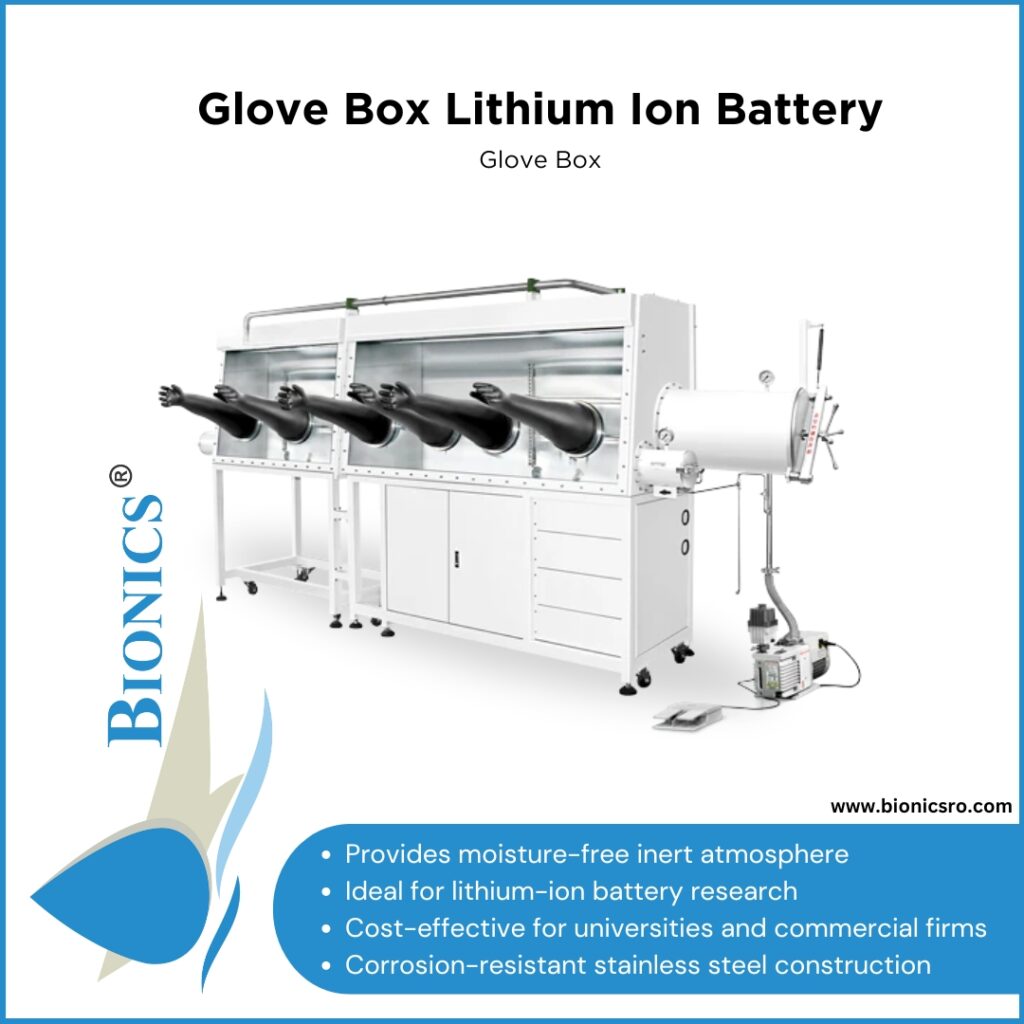Stay up to date
Stay up to date with our monthly e-newsletter
* We will never share your email address & you can opt out at any time, we promise.
In energy storage technology, lithium-ion batteries are an essential part of it and are used in devices like mobile phones and electric vehicles.
As more advanced and dependable batteries continue to gain popularity, research and development necessitates glove boxes and isolators for materials under controlled environments.
This equipment’s are required to handle the materials and conduct precise experiments, thereby providing a dry atmosphere for lithium-ion batteries in order to improve their efficiency.
Glove-box Systems account for all innovative aspects of studying battery systems as well as their influence on the sector.
The vacuum chamber is maintained by drawing out air, introducing process gas (nitrogen or argon), and reintroducing it to normalize pressure and achieve low moisture content and oxygen percentage.

Glove box refers to an enclosed chamber utilised for handling substances that may pose danger, like lithium-ion batteries containing dry air or inert gas (argon or nitrogen), which prevents reactive substances from contacting moisture or oxygen at any time. Lithium-ion battery testing and production processes that are risky. Researchers using them because they possess highly oxidising properties require strict conditions and equipment. In tests or assembly where the cathode and anode materials need to be kept away from water but also for purposes of stopping any decomposition reaction with water as well as preventing water electrolysis.
Bionics Consortium is one of the leading manufacturers of glove boxes in India, which supplies a moisture-free environment necessary for making lithium-ion batteries that can’t corrode due to oxidation. The glove boxes have been designed so that they produce quality products in a low-cost range applicable in Indian markets with 10mm thick tempered glass, a sliding tray, a PLC with HMI and an LED tube light, a gas purification system with a circulation blower, a solvent absorber system with an oxygen and moisture analyser inside the anti-chamber having a sliding tray, and SS 304 piping having a vacuum pedal and a and a high-quality solenoid valve. The glove boxes have a leakage rate below 0.001%. These contain gas purification systems, including catalysts and molecular sieves for O2 and H2O removal. Bionics Consortium makes such things as glove box systems for lithium-ion battery R&D components in an oxygen-free or moisture-less environment.
Another name for glove boxes is isolation chambers or controlled atmosphere enclosures, which are indispensable in a number of disciplines, including battery research. By controlling environments that are less humid and contain less oxygen, these provide conducive settings that allow scientists and manufacturers to undertake experiments using susceptible substances such as lithium-ion batteries at optimum conditions. This paper therefore seeks to highlight some features of glove boxes in terms of battery applications and how they hold potential for the growth of battery technology.
These are critical components in batteries’ research, development, and production processes, considering that they prevent cross-contamination and maintain faithfulness towards the performance of units. Lithium-ion batteries cannot stand moisture or oxygen; hence, there is a need to keep them safely stored away from sources that may cause short-circuiting or other damage because they are prone to moisture and oxygen. This is especially true within areas concerning physics, chemistry research, and even energy storage technologies.
Circulation of air is the basic principle behind the glove box. The gas circulation system and a working chamber are collectively known as an operation box. First, unwanted elements like oxygen molecules and water vapour present in the cabinet must be gotten rid of by introducing an inert gas such as argon or nitrogen into it initially. This is called the gas washing process. The remaining impurities in the cabinet are removed through the circulating purification system so that their quantities do not exceed 1 ppm each in the water and oxygen contents of the operation box.
Lithium-ion batteries are made by following a multi-step process that includes several critical steps.
Battery preparation procedure
There are several reasons why glove boxes cannot be avoided in lithium-ion battery production.
Whenever a piece or a part is maintained inside the inner chamber and this air has been drawn out through the vacuum pump, then process gas (nitrogen or argon) is admitted into the chamber to match atmospheric pressure. The vacuum controller holds the pressure of the chamber at some set time while sometimes applying vacuum. After the vacuum cycle, nitrogen or argon, which are usually dry, clean process gases, are re-introduced into the chamber to normalise its pressure. This sequence can be repeated severally until the required low moisture content is achieved as well as a low oxygen percentage in the device.
Stay up to date with our monthly e-newsletter

Bionics Consortium Pvt. Ltd. is a premier Indian company specializing in the manufacturing, supplying, and exporting of laboratory and scientific equipment, available in both standard and custom designs.
Copyright © 2024 Bionics Consortium Pvt. Ltd – all Rights Reserved.